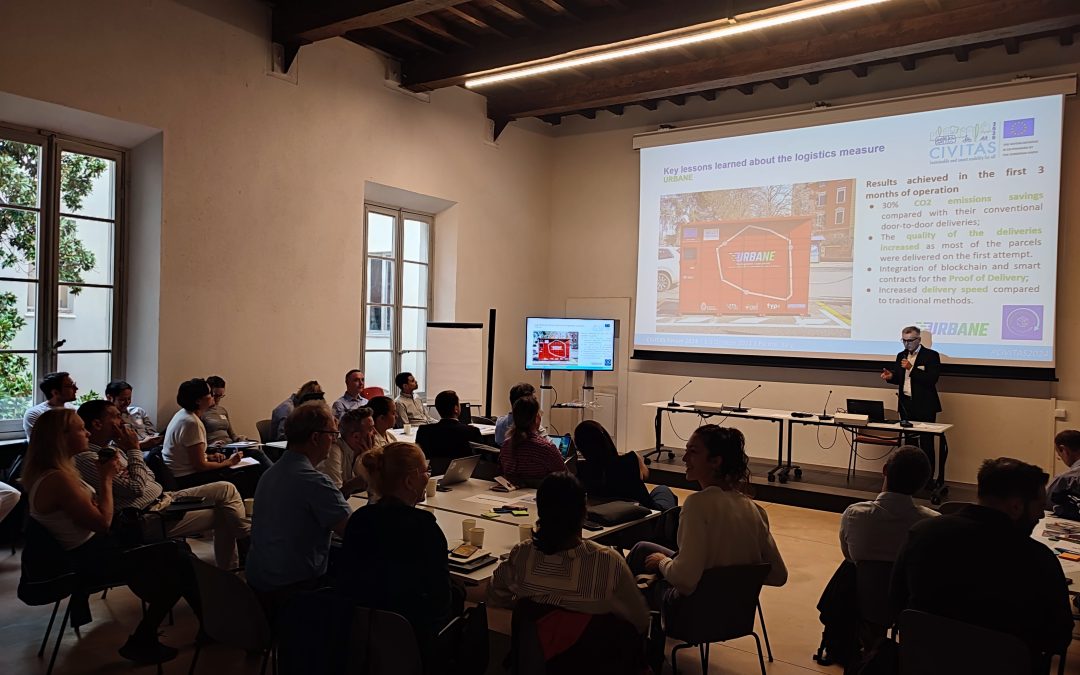As part of the CIVITAS Forum that took place in Parma, Italy, from 1-3 October 2024, the URBANE’s Green Last-Mile Logistics City Platform and the CIVITAS Initiative organised an interactive workshop showcasing sustainable last-mile solutions led by city or regional authorities in Hamburg, Bologna, and Thessaloniki. Gathering city and regional representatives, as well as other experts from the sector, the workshop was a space for exchange and sharing of experiences in the decarbonisation of last-mile logistics.
Three cities in the spotlight
The three invited cities presented their latest last-mile initiatives which were then analysed in-depth during the roundtable discussions to explore their transferability potential.
BOLOGNA
Luca Bellinato, from the Bologna Mobility Department, presented a handful of Bologna’s logistics solutions in their Low Traffic Zone. As part of URBANE and MOVE21, the city aims to promote the shared use of public space, foster sustainable business models, and improve the governance of urban logistics. To achieve these, they are implementing a three-folded measure including:
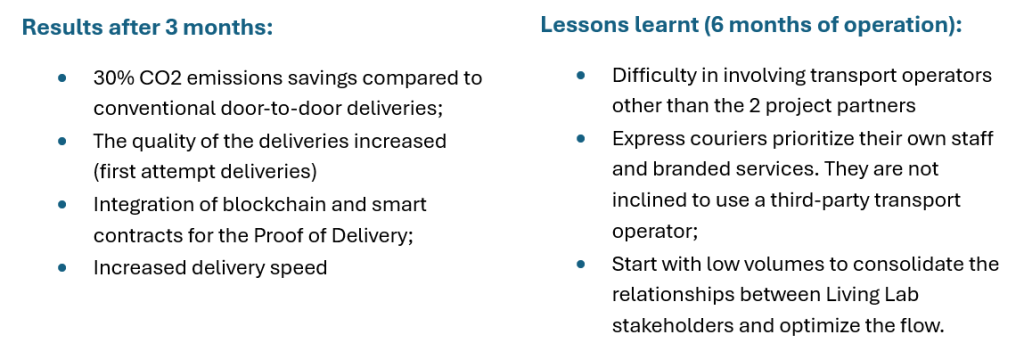
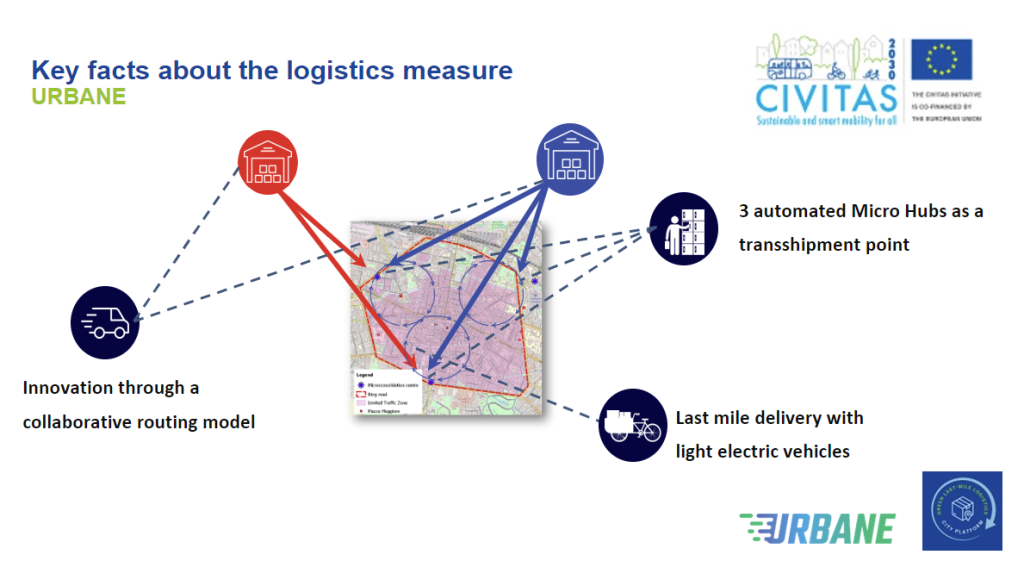
© Luca Bellinato’s Powerpoint Presentation
HAMBURG
Sophronius Schalies from the Hamburg Logistics Initiative, a public-private partnership from the metropolitan region and beyond, presented what they are testing in Hamburg in the DECARBOMILE and MOVE21 EU-funded projects:
- River logistics
In DECARBOMILE, they are connecting the waterways with the last-mile logistics network by using electric boats, identifying unloading sites in the city, and deploying e-cargo bikes for last-mile deliveries. However, waterway mobility raises new challenges such as predicting the tide, current, weather, and travel time correctly to allow the logistics service provider to plan accordingly. The City of Hamburg is proving just that by integrating urban waterways into existing logistical delivery chains.
2) Multifunctional neighborhood hubs
In MOVE21, they are implementing multifunctional neighbourhood hubs that include mobility solutions for passengers and logistics which are integrated with social and cultural needs. Each hub has different functionalities, for example, the Holstenstraße hub works as a micro depot for last-mile logistics, as a distribution point for food and clothing for people in need, and also as a space for social counselling and support.
3) Combined transport of people and goods using an on-demand shuttle.
In addition, in MOVE21, Hamburg is testing this combination using on-demand shuttles while including a social approach at its core. These aim to improve services for social aid organisations while using existing resources and capacities more efficiently. This solution has proven to have potential, especially when integrated into public transport and taxi systems and it can ensure a relevant volume of real shipments.
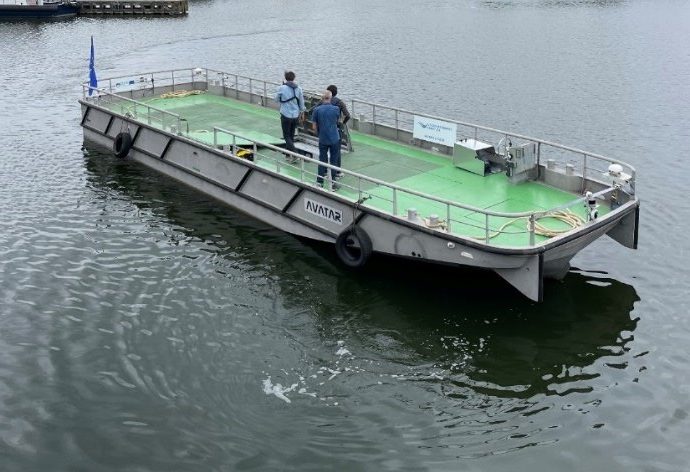
Second last mile: Electric boat, © DECARBOMILE, AVATAR

© Oliver Lang / Smart City | DB
THESSALONIKI
Lastly, Zisis Maleas from CERTH, presented URBANE’s Thessaloniki Living Lab which involves the installation of micro-fulfilment centres in public spaces at the perimeter of the historical centre and implementing a Hub & Spoke delivery business model. To achieve this, they have used four different tools and methodologies:
- Facility location: Optimal sizing and configuration of the network
- Blockchain: Transparent, reliable, and resilient transaction on shared locker operations
- Agent-based behavior analysis: In-depth understanding of customer behavior
- Green delivery Digital Twins: Zero emissions and sustainable delivery with green vehicles with Dynamic Routing
They have also created a “Locker Alliance network” with four main goals:
- Support companies to design their parcel locker network in order to optimize their green last mile operations
- Provide argument for city authorities to guide LSPs to mitigate on collaborative business models with shared assets
- Support city authorities to design SULP by considering new urban space allocation policies
- Merging of different data sources for feasibility checking
Their pilot highlighted three key lessons: stakeholder engagement and adaptability are crucial, as shown by ACS’s commitment upon recognising the benefits of participating in the locker alliance network could have in terms of delivery efficiency. The pilot tests confirmed that blockchain technology could enhance logistics transparency and security without needing major IT infrastructure overhauls. Finally, locker placements should be informed by diverse data and stakeholder input.
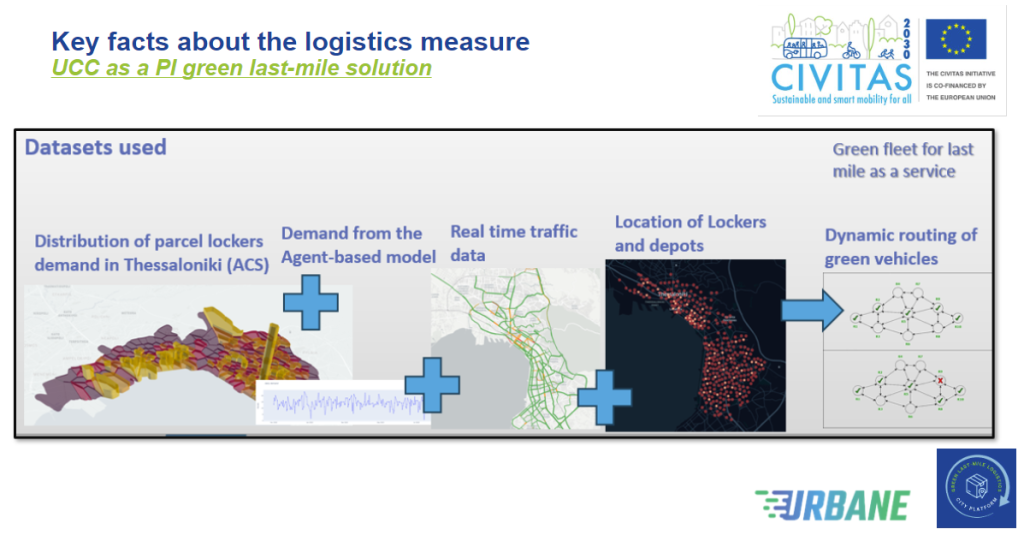
© Zisis Maleas’ Powerpoint Presentation
Deep-diving into the cities’ solutions
In the second part of the workshop, participants – who were mainly representatives of cities and regions throughout Europe – were split into roundtables. The main discussion points were:
Bologna roundtable
Discussions were centered around the role of Logistics Service Providers (LSPs) and solutions to enhance collaboration between LSPs and other stakeholders.
- LSPs often hesitate to collaborate due to branding concerns, legal liabilities, and difficulties in adjusting their business models and IT systems to smaller-scale operations. Despite recognising the value of collaboration, they require supportive policies and a business case to justify the costs of shared operations.
- Suggested solutions include a centralised platform for coordinating deliveries, larger strategically placed lockers, and carsharing models as a framework to share infrastructure. If voluntary collaboration proves difficult, stronger regulations may be necessary.
- Blockchain and smart contracts could address legal challenges, and models like Norway’s public procurement approach to public spaces offer successful examples of enabling collaborative delivery systems.
Thessaloniki roundtable
During the discussions, there was an overall consensus on the benefits of implementing micro-hubs and locker networks.
- City representatives shared their different experiences and how in most cases this type of solution has helped improve urban logistics in their territories.
- It is crucial to place lockers in secure, convenient locations, preferably at multimodal transport hubs, to encourage user engagement.
- Engaging stakeholders from the beginning is vital to ensure their support and participation.
- The long-standing living lab in Thessaloniki serves as a valuable example of fostering stakeholder collaboration.
- While city-level collaborations are progressing, challenges remain in coordinating efforts with other levels of governance, such as regions or provinces.
Hamburg roundtable
In this table, many solutions were discussed.
- Hamburg’s “river mobile hub” concept using barges to transport containers for cargo bike deliveries attracted a lot of interest. The barrier to acquiring the necessary permits for these operations was discussed, which requires robust support from the relevant authorities.
- The concept of “synchro delivery”, using public transport buses to deliver goods at the city stops, was discussed. An issue identified is the rigidity of customers. Solutions? Installing lockers at bus stops or using on-demand shuttles, which may offer greater flexibility. A representative from Madeira explained how they use buses as mobile marketplaces turning them into a “travelling store”.
- Finally, the business models of Hamburg’s modular logistics hubs which combine logistics services with social support, were talked about. Logistics clients pay for utilities like electricity, gas, and water, while the social aspect is managed by those receiving support, who help by keeping both facilities clean, was seen as an interesting example of how to merge two different activities in a commonplace. This concept could be further enhanced by aligning the training programs with jobs in logistics, such as warehouse work or delivery services.
